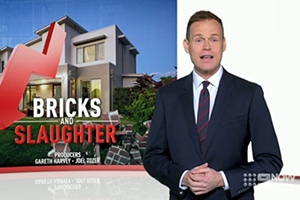Please fill out the details below to receive information on Blue Wealth Events
"*" indicates required fields

Much talk has been made over the sensationalist 60 Minutes segment on the Australian property market, with the name very much hinting at what was to come, ‘Bricks and slaughter’. The report which dramatically told the story of all the risks and external factors which can affect the property market has been heavily scrutinized by many leading research firms in the country. It’s one-sided nature and extreme concepts are typical of fear mongering. We’d like to weigh in on the conversation and once again, bring some perspective to the situation.
Here are the key points which were discussed:
‘A 40% decline in property values over the next 12 months as a result of the end of Australia’s property boom’
There’s no hiding the fact that in the last few years price growth has been extremely strong, particularly in both Sydney and Melbourne. What they’ve failed to note is that this isn’t the first time we’ve seen strong levels of growth in consecutive years and it’s not the last. Property markets are cyclical, we’re likely to now see Sydney transition into a period of correction which may lead to value declines of 10 – 15%. A 10 – 15% decline may be a cause for concern but it’s unfair to look at this in isolation without considering the 75% growth which we’ve had in the 5 years prior. 60 Minutes reproduced the magical number of 40 – 45% when predicting Australia-wide price drop over the next 12 months. The 40% figure has been used many times before. While the objective, research focussed CoreLogic are estimating house values to decline 1.6%, which is completely justifiable when considering the 9.5% growth experienced in 2017.
The market correction is being driven by a strain on affordability and fewer buyers in the market. The tightening of bank lending has limited potential buyers and put a strain on property demand.
Louis Christopher, who played an instrumental role as the reports’ ‘Market Analyst’ publicly stated after the interview that the report failed to show the two sides to his story. Unfortunately for him, his 45-minute market research conversation was tampered with to fit into the 60 Minutes agenda and he only featured for about one minute. The program only covered his statements on risk and over-valuation rather than discussing the safety valves still present in the market, for example strong population growth, strong economies and the unlikely event of banks failing.
‘The rising number of people with significant mortgage stress’
60 Minutes discussed the rising risk of foreclosure in the suburbs because of a strain on those with mortgages. The Australian Bureau of Statistics collects data on the average household mortgage repayments in comparison to the average household income. If mortgage repayments are more than 30% of the average household income, this can be considered mortgage stress to some degree. The Greater Sydney data from the 2016 census recorded that figure at 8.4%, a decline from the previous 2011 census where 12% of households were recorded to be paying over 30% of their income on their mortgage repayments. This decline occurred over one of Sydney’s most significant growth periods.
Much of the segment focused on mortgage struggles of individuals who have poorly managed their financial decisions. Although we sympathise with these people, to generalise the entire Australian population’s financial situation based on a highly leveraged retiree is quite ridiculous.
As with all investments there is an element of risk otherwise there’d be no reward. So, to provide some more insight, here are the things which would need to occur at the same time for there to be the risk of a housing bubble:
The generalisation of the entire Australian property market being at significant risk is speculative. Australia has cemented itself as one of the most desirable countries in the world. We, as Australians are some of the healthiest, wealthiest and generally privileged people on the planet. People from all over the world want to be apart of it. This desirable lifestyle will remain a key driver for sustained demand for Australian property.
The longevity of property in Australia
We’re firm believers in the consistency and trend of property cycles. As a result, we agree that there will be a price correction, particularly in the Sydney market. We’re also firm believers of the long-term performance of the Australian property market. Understanding that population growth is the foundation of property demand provides an insight into the longevity of property in Australia. Our population growth continues to outpace the estimates made by the Australian Bureau of Statistics. Simply put, these people need a place to live. We have now reached 25 million people 33 years earlier than anticipated and the next milestone will be the same.
